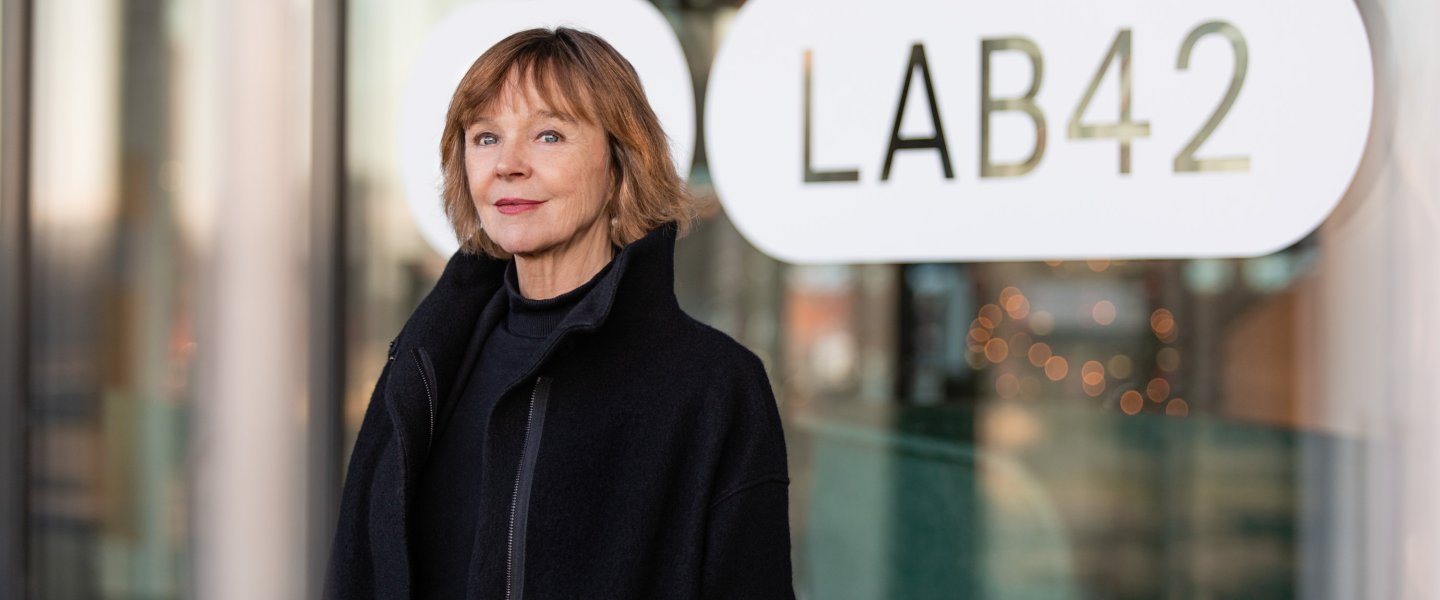
'Companies are having a lot of data, but they often lack the tools to put it to good use.'
Like her students, Director of the College of Informatics Jacobijn Sandberg recently relocated to LAB42. She hopes the new building will lead to many inspiring collaborations between researchers, students and businesses.
'It's so light and spacious here', Jacobijn Sandberg remarks at the start of the interview. She has been working from her new office on the fourth floor of LAB42 for six weeks and is enjoying the new surroundings. 'In the few weeks I've been here, I've almost met more colleagues than I did all those years in the faculty building next door.'
Why is that?
'All the natural science disciplines are located in that building. In addition to direct colleagues from the Informatics Institute, you could just as easily run into a chemist or zoologist.
Here, you can be sure everyone you meet is 'one of us'. That means I'm far more likely to approach people for a quick chat.'
Most of the rooms in LAB42 have glass walls, so you can see what's going on everywhere. Does that make it easier to strike up a conversation?
‘Yes, absolutely. The building was also designed to offer lots of different spaces for people to interact. It has a really playful layout with lots of green open spaces and little nooks in unexpected places.'
The College of Informatics is part of the Informatics Institute and consists of three Bachelor's programmes: Computing Science, Information Science and Artificial Intelligence. All three degree programmes have seen an increase in student numbers in recent years.
'We have grown quite a lot. 'Twenty years ago, all three programmes combined probably had around 100 first-year students, and we're currently at over 400.'

These days, information technology has a much 'hipper' image than it used to. Why is that?
'I think it's partly because people are increasingly aware that information technology is an inseparable part of everything we do. We just couldn't live without it. Smartphones would be a good example - they've almost become an extension of ourselves. I also think information scientists have started to communicate more about what they actually do to the non-academic world.'
How would you explain those changes?
‘Universities have always been kind of insular and introspective places anyway. That's all changing now with the influx of new blood. The new generation grew up with technology and tend to be interested in socially relevant research.'
In that sense, the new LAB42 building reflects the changing culture at the Institute of Computing Science. No more closed doors, but an open atmosphere and a layout that encourages collaboration. The building's third floor has been reserved for companies, who can rent office space in order to facilitate collaboration.
So how can an office at LAB42 benefit those companies?
'Companies are having a lot of data, but they often lack the tools to put it to good use. They need researchers to help them do that. Researchers need large datasets to do effective research. At LAB42, they can use that data to develop new algorithms and data analysis techniques. Those kinds of exchanges had already been taking place for several years through the ICAI labs [Innovation Center for Artificial Intelligence, ed.].
LAB42 aims to intensify collaboration between researchers and the commercial sector. The companies who set up offices here tend to be active in the fields of data science, AI, infrastructure and digital innovation.’
‘They're also closer to our students, which obviously offers lots of benefits. Our students are in great demand on the labour market because of their unique skills and expertise. They're also a great window into the latest developments in digital innovation and AI. It works both ways, though. Working closely with commercial partners gives researchers and students a better understanding of the market's current needs. Not that we should only be doing research in response to societal demands, but it's good to see both. We need to combine fundamental research that doesn't necessarily translate into practical applications with socially relevant research.'
'Another option is the refresher course. Today's workforce needs to make sure they are always up to date in terms of knowledge and skills. Our researchers can offer a lot of the knowledge they need. While companies can obviously enlist the expertise of our researchers, having certain knowledge and skills in-house can pay off in the long run. We're currently exploring the options for offering staff retraining modules.’
To finish, which collaboration project would you like to highlight?
'The Blue Student Lab is a good example of an ongoing collaboration between students and industry. This project is aimed at students from all three degree programmes. They do their own individual graduation projects, but the subject has to focus on the same common theme determined by the participating company.
For example, we did a project with ABN AMRO. Students worked in the same space, which allowed them to learn from each other. They were also in regular contact with experts from ABN AMRO. The project was themed around the issue of digital security.’
The Blue Student Lab is appealing to companies because it explores the same subject through the lens of different disciplines: ‘For example, an information science student might assess the authorisation protocols, or in other words; who actually has access to these systems? A Computing student might focus on software that helps you prevent your system from being hacked, while an AI student would figure out a smart way to intercept hacking attempts.'